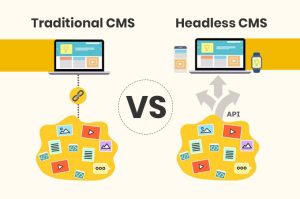If you are looking to develop a website for your business, you are most likely to have been through the debate of Traditional CMS vs Headless CMS and the implications it poses to your business. A Content Management System or CMS is a crucial component of modern-day websites, allowing an application to manage digital content without code or developing new pages.
Understanding the difference
A Traditional CMS, also known as coupled CMS connects the front-end and back-end of a website, allowing for an easier method of managing online content. Having everything linked systematically means carrying out changes in the backend will reflect on the frontend with minimal configuration. Examples of Traditional CMS include WordPress, Magento, Squarespace, Drupal, etc.
A Headless CMS, on the other hand, is a backend-only Content Management System that just deals with the content. Once the content is created and edited, it can be published using an Application Programming Interface (API). A Headless CMS poses no impact on the front-end and provides greater flexibility in getting your content out.
Noting the Positives
Traditional CMS
- Easy to manage the entire content.
- The entire site is maintained from a single system.
- Large community support.
- The technical barrier for entry is lower.
Headless CMS
- Content can be easily published on any device
- Not dependent on the front end. It allows developers the freedom to use their framework and tools.
- With the headless API, developers do not need to worry about the content but just concentrate on the presentation.
- Makes it much easier to create and disseminate content.
Weighing the Cons
Traditional CMS
- Not scalable.
- Requires dedicated developers who are CMS specific.
- Offers very limited flexibility.
- More resources (both time and money) are required for maintenance.
Headless CMS
- More efforts are required for upfront configuration.
- Unavailability of the content preview.
Final Thoughts
If you are establishing a small business or a small enterprise solution that doesn’t require sharing content on other digital platforms, you can certainly go ahead with a traditional CMS. It allows you to manage your site from a single platform and can get your site up and running fast. Traditional CMS solution also comes with plugins that allow multi-site/API access that grant them autonomy to share digital content with external resources.
A headless CMS, on the other hand, is a good solution for websites that use JavaScript frameworks such as React, Angular, or VueJs, or if you have native mobile apps. It also provides a platform that allows users to publish content simultaneously across multiple platforms. Headless CMS is a scalable solution, that can grow along with your business needs.
While no one solution can solve all problems, it is wise to weigh in all the pros and cons before you zero on a solution for your business. Citytech Software offers customized solutions to help businesses around the world to streamline their business process, improve efficiency and the bottom line. To know more visit www.citytechcorp.com.


